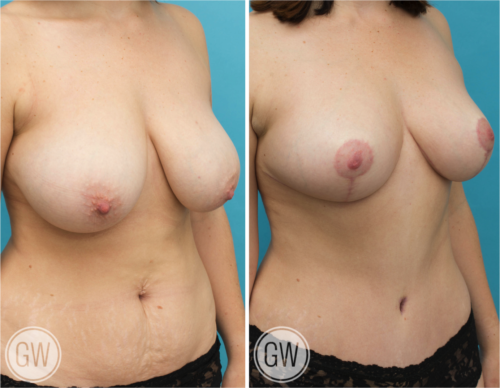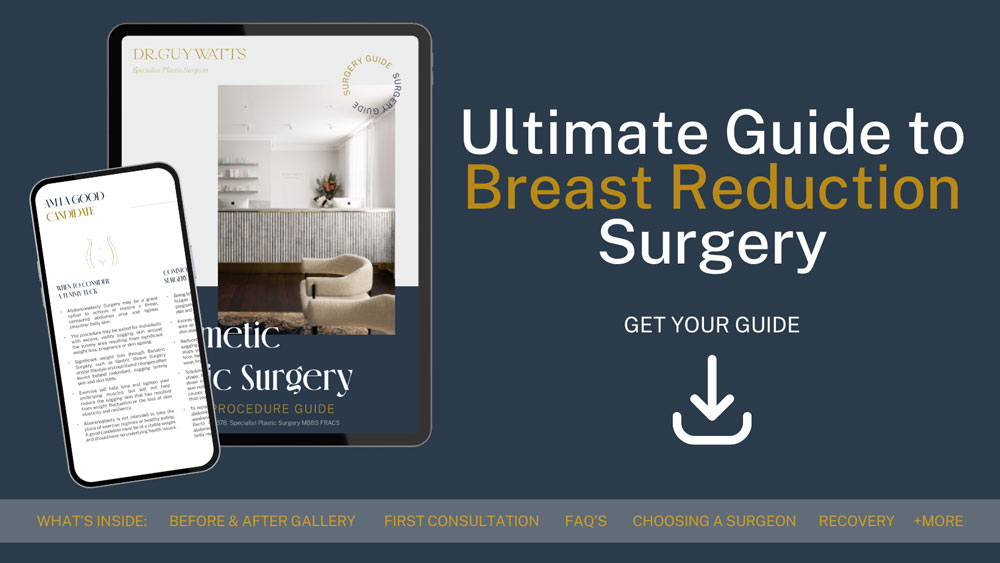
06 Jun How to Reduce Bruising after Breast Reduction
Strategies to Address Bruising After Breast Reduction Surgery
If you’ve recently undergone breast reduction surgery or are planning to have the procedure, you might be concerned about post-operative bruising. Bruising is a common side effect of breast reduction surgery, but there are several steps you can take to reduce its extent and severity. In this blog, Perth Specialist Plastic Surgeon Dr. Guy Watts will discuss practical recommendations to help you reduce bruising and optimise your recovery process.
Take our quiz, and find out if you are ready for surgery
Dr. Watts’ Recommendations to Reduce Bruising after Breast Reduction
Follow Dr Guy Watts’ Instructions
The most important thing you can do to reduce bruising after breast reduction surgery is to carefully follow Dr Guy Watts’ post-operative instructions. These guidelines are tailored to your specific case and are designed to promote optimal healing. Make sure to attend all follow-up appointments and don’t hesitate to ask questions if anything is unclear.
Apply Cold Compresses
Applying cold compresses to the surgical area can help reduce swelling and bruising. Use ice packs or bags of frozen vegetables wrapped in a thin towel to avoid direct contact with the skin. Apply the cold compress for 15-20 minutes at a time, several times a day, during the first 48-72 hours after surgery. This helps constrict blood vessels and reduce bleeding under the skin.
Elevate Your Upper Body
Keeping your upper body slightly elevated while resting or sleeping can help reduce swelling and bruising. Use pillows to prop yourself up at a comfortable angle. This position helps increase circulation and prevents fluid from accumulating in the surgical area.
Wear Your Compression Garment
Dr. Watts will recommend a compression garment or surgical bra to wear after the procedure. These garments apply gentle pressure to the surgical area, helping to reduce swelling and support the healing process. Wear the compression garment as directed by Dr. Watts, typically for several weeks after surgery.
Avoid Strenuous Activities
It’s important to avoid strenuous activities and heavy lifting for at least 4-6 weeks after your breast reduction surgery. Engaging in intense physical activity too soon can increase swelling, bruising, and the risk of complications. Stick to light, gentle movements and gradually increase your activity level as Dr. Watts allows.
Avoid Blood-Thinning Medications and Supplements
Before your surgery, Dr. Watts will advise you to stop taking certain medications and supplements that can increase the risk of bleeding and bruising. These may include aspirin, ibuprofen, vitamin E, fish oil, and herbal supplements like ginkgo biloba and garlic. Make sure to provide Dr. Watts with a complete list of your medications and follow his instructions regarding when to stop and resume taking them.
Avoid Certain Herbal Supplements
Some herbal supplements can increase the risk of bleeding and bruising. These include ginseng, ginger, garlic, and high doses of vitamin E. While some of these supplements may have potential health benefits, it’s important to discuss their use with Dr. Watts before and after your surgery. He may advise you to stop taking certain supplements for a period of time to reduce the risk of complications.
DOWNLOAD DR WATTS’ GUIDE TO BREAST REDUCTION

Use Arnica Montana
Arnica Montana is a homeopathic remedy known for its potential to reduce bruising and swelling. It is available in various forms, such as oral tablets, topical gels, and creams. While the scientific evidence supporting its effectiveness is limited, you may find it helpful in reducing bruising. Consult with Dr. Watts before using any homeopathic remedies to make sure you can take them without any negative side effects.
Be Patient and Give Yourself Time to Heal
Remember that bruising is an expected part of the healing process after breast reduction surgery. While the recommendations mentioned above can help reduce its extent, it’s important to be patient and give your body the time it needs to heal. Most bruising will subside within 2-3 weeks, but some residual discoloration may persist for several more weeks. Trust the process and be kind to yourself during recovery.
Avoid Smoking and Alcohol
Smoking and alcohol consumption can impair your body’s healing process and increase the risk of complications after surgery. Nicotine constricts blood vessels, reducing blood flow to the surgical area, which can delay healing and worsen bruising. Alcohol can also contribute to increased swelling and bleeding. Avoid smoking and alcohol for at least 3 months before and after your surgery.
Avoid Smoking and Exposure to Second-hand Smoke
In addition to avoiding smoking yourself, it’s important to stay away from second-hand smoke during your recovery. Exposure to second-hand smoke can also impair healing and increase the risk of complications. If you live with a smoker, ask them to smoke outside and away from your recovery area. Ask them to wash their hands and change their clothes before interacting with you to reduce your exposure to smoke residue.
Get Plenty of Rest
Getting adequate rest is crucial for your body’s recovery process. During the first few days after surgery, you may feel tired and experience some discomfort. Listen to your body and allow yourself to rest as much as needed. Avoid overexerting yourself, as this can increase swelling and bruising. Taking short, gentle walks around your home can help increase circulation, but make sure to balance this with periods of rest.
Wear Loose, Comfortable Clothing
Opt for loose, comfortable clothing that can be put on and taken off with ease during your recovery. Avoid tight-fitting clothes that put pressure on your chest, as this can irritate the surgical area and exacerbate bruising. Button-up shirts or loose dresses can be good options, as they don’t require you to lift your arms over your head.
Manage Pain with Prescribed Medication
Your anaesthetist will prescribe pain medication to help manage discomfort during your recovery. Take the medication as directed and avoid exceeding the recommended dosage. If you experience severe pain or the prescribed medication isn’t providing sufficient relief, contact Dr. Watts’ team for guidance.
Avoid Sun Exposure
Sun exposure can cause hyperpigmentation and darken bruises, making them more noticeable and potentially prolonging their appearance. During your recovery, avoid direct sunlight on your chest area. If you need to go outdoors, wear protective clothing, such as a loose-fitting shirt with a high neckline, and apply a broad-spectrum sunscreen with a high SPF to any exposed skin.
Massage the Area
Once Dr. Watts gives you the go-ahead, massaging the surgical area can help increase circulation, reduce swelling, and promote the breakdown of bruising. Use a light, circular motion and avoid applying too much pressure. Dr. Watts may also recommend specific massage techniques or provide you with a demonstration during your follow-up appointments.
Consider Lymphatic Massage
Lymphatic massage is a specialised technique that helps stimulate the lymphatic system, reducing swelling and promoting the removal of excess fluid and waste products from the body. Research suggest that lymphatic massage can help reduce bruising and speeds up the healing process. Consult with Dr. Watts to see if lymphatic massage is appropriate for you and if he can recommend a qualified massage therapist experienced in post-surgical care.
Use Silicone Sheets or Gels
Silicone sheets or gels can be applied to the incision sites once they have fully closed and healed. These products have been shown to help reduce the appearance of scars and may also help reduce bruising. They work by placing a protective barrier over the skin, helping to keep the area hydrated and promoting collagen production. Talk to Dr. Watts about when it’s appropriate to start using silicone products and which brands are recommended.
Be Mindful of Your Arm Movements
In the initial weeks after your breast reduction surgery, be cautious about lifting your arms above your head or reaching for objects on high shelves. These movements can put strain on your incisions and potentially increase swelling and bruising. If you need to reach for something, ask for assistance or use a grabber tool to avoid overextending your arm movements.
Maintain a Stable Weight
Significant weight fluctuations after your surgery can affect your results and potentially prolong bruising and swelling. Aim to maintain a stable, healthy weight through a balanced diet and gentle exercise, as approved by Dr. Watts. Rapid weight gain or loss can cause changes in your breast size and shape, which may impact your healing process and the appearance of bruising.
Attend a Post-Operative Bra Fitting
Once Dr. Watts determines that you’re ready to transition from your surgical compression garment to a regular bra, consider attending a professional bra fitting. A well-fitted, supportive bra can help reduce any residual swelling and bruising while maintaining comfort. Look for bras with soft, breathable fabrics and wide, adjustable straps to accommodate your changing needs during recovery.
FAQs about Recommendations to Reduce Bruising after Breast Reduction
How long does bruising usually last after breast reduction surgery?
- Bruising after breast reduction surgery usually begins to fade within the first two weeks. However, it can take up to several weeks for the bruising to completely disappear.
- The duration can vary depending on individual healing rates and adherence to post-operative care instructions.
Can certain foods or drinks help reduce bruising after my surgery?
- Yes, consuming foods rich in vitamin K, such as leafy greens, broccoli, and Brussels sprouts, can help with blood clotting and potentially reduce bruising.
- Additionally, staying hydrated by drinking plenty of water can support your overall recovery and help your body heal more effectively.
Can I use over-the-counter creams or ointments on bruises after breast reduction surgery?
- It is important to consult with your surgeon before applying any over-the-counter creams or ointments on your bruises.
- While some products, like arnica gel, may be recommended to reduce bruising, others may interfere with healing or irritate your skin.
How can I tell the difference between typical bruising and a complication that needs medical attention?
- Bruising after breast reduction surgery will generally fade over time and is often accompanied by some swelling and tenderness.
- Signs of complications include severe pain, excessive swelling, redness, warmth, pus at the incision sites, and fever.
- If you experience any of these symptoms, contact your surgeon immediately.
Are there any activities I should avoid to prevent worsening my bruising after breast reduction surgery?
- Yes, to prevent worsening bruising, you should avoid strenuous activities, heavy lifting, and high-impact exercises for at least four to six weeks post-surgery.
- Additionally, it’s advisable to avoid bending over or lifting your arms above your head, as these movements can increase blood flow to the breasts and exacerbate bruising.
- Always follow your surgeon’s specific guidelines on activity restrictions.
Further Reading about Breast Reduction Surgery with Dr. Guy Watts
- Read more about Top 10 Methods to Reduce Scars after Breast Reduction Surgery
- Read more about How to Reduce Bruising after Breast Reduction
- Read more about Neck Pain and Breast Reduction
- Read more about What Are Expected Symptoms to Experience During Breast Reduction Recovery
- Read more about Otions for Heavy Breasts – Breast Reduction
- Read more about Will Medicare Cover My Breast Reduction?
- Read more about Exercising after Breast Reduction
- Read more about How to Choose the Compression Garments after Breast Reduction
Medical References about Reducing Bruising after Breast Reduction
- Breast Reduction Surgery – Mayo Clinic
- Breast Reduction Surgery: Everything You Need to Know – Medical News Today
- Breast Reduction Surgery – WebMD
- Breast Reduction – Cleveland Clinic
- Breast Reduction – NCBI
About Dr. Guy Watts – MED0001539378
FRACS (Plas) – Specialist Plastic Surgeon In Perth WA
Dr. Guy Watts is a Specialist Plastic Surgeon (AHPRA MED0001539378) with an extensive career that spans across renowned plastic surgery clinics worldwide. His experience has been honed through invaluable experiences at esteemed establishments such as the New York Eye and Ear Infirmary and the renowned Pitanguy Clinic in Brazil.
Having collaborated with the foremost cosmetic plastic surgeons on a global scale, Dr. Watts has chosen to return to Perth after a 17-year journey of intensive training and invaluable professional experience to bring the latest practices and technology in cosmetic plastic surgery to his patients.
Dr. Watts is a Fellow of the Royal Australasian College of Surgeons (FRACS) and a Member of the Australian Society of Plastic Surgeons (ASPS), Australasian Society of Aesthetic Plastic Surgeons (ASAPS) and the International Society of Aesthetic Plastic Surgeons (ISAPS).
Read about the potential Risks and Complications of Surgery
Read the Patient Information and Resources
About CLINISPA
Clinispa is Dr Watts’ bespoke medical clinic performing Cosmetic Aesthetic treatments. At Clinispa, we offer advanced clinical treatments in a luxurious and calming environment, tailored to support your skin’s health and appearance.
Clinispa aesthetic services are performed by Dr Guy Watts’ nursing professionals, who have a passion for and solid understanding of facial aesthetics.
All Clinispa clients are considered individually, with a personalised treatment plan consisting of advanced scientific approaches to cosmetic aesthetics. We incorporate innovative technologies in conjunction with superiorly formulated skin care.
For more information about the full range of Clinispa Aesthetic of Cosmetic Treatments visit the Clinispa website








Sorry, the comment form is closed at this time.